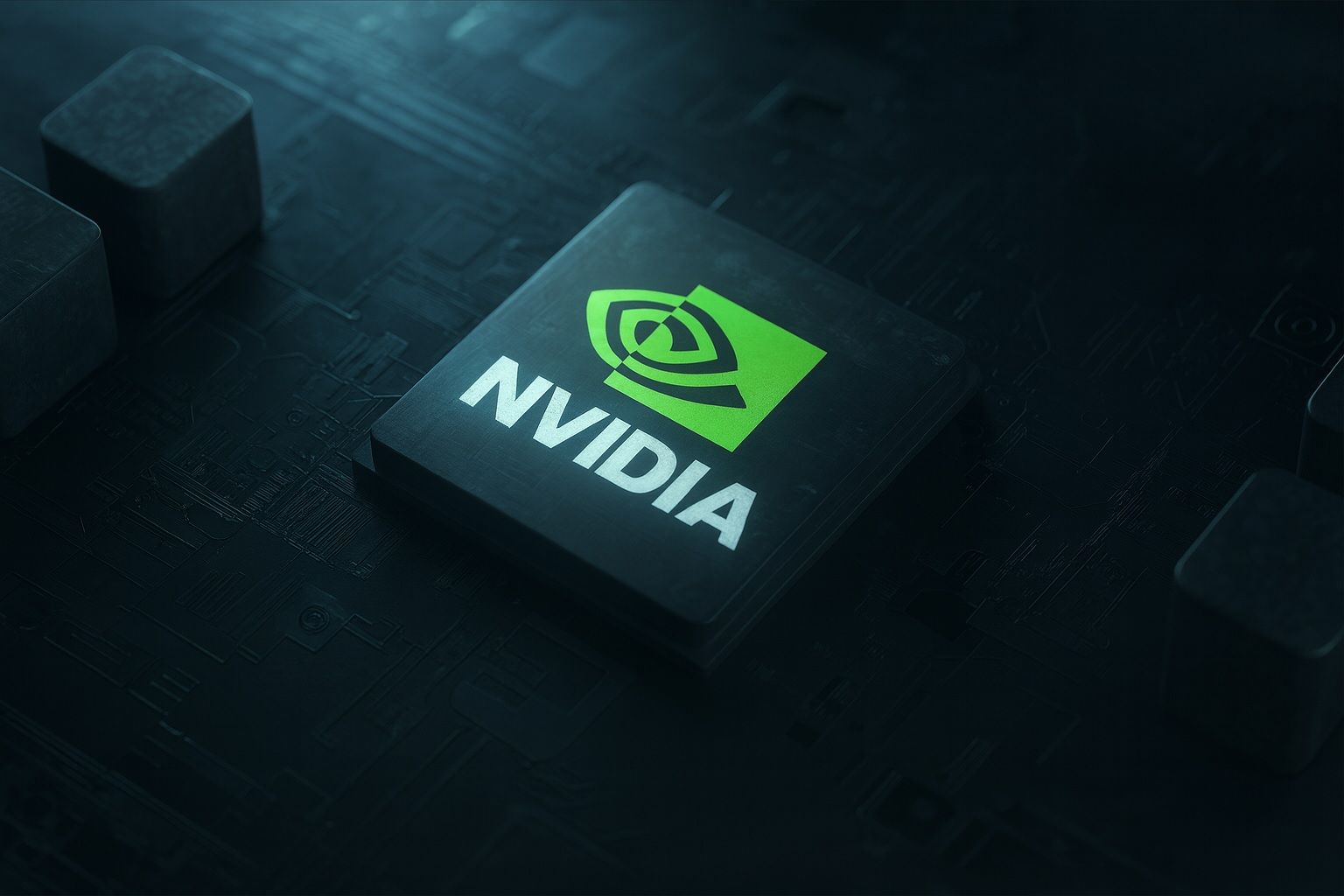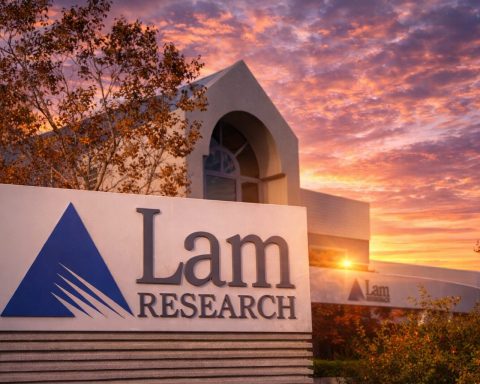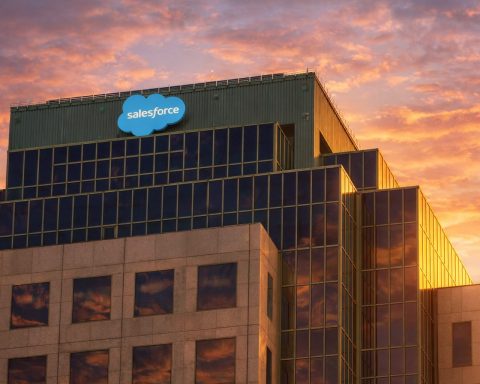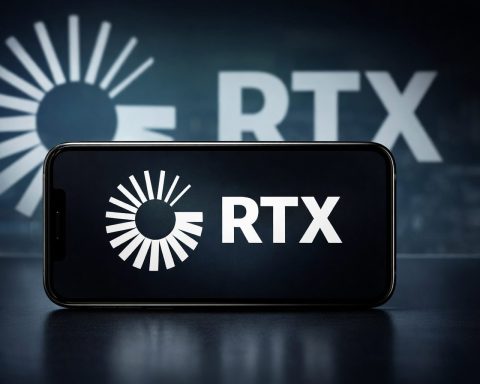- Near Record Price: Nvidia’s stock (NASDAQ: NVDA) closed around $186 per share on Oct. 24 – just shy of its all-time high (~$195) – valuing the chipmaker at roughly $4.4 trillion [1]. The stock has climbed about 30% year-to-date, vastly outperforming the S&P 500 [2], and is up ~58% from a year ago [3].
- AI Gold Rush Fuels Growth: Explosive demand for Nvidia’s AI chips drove revenue up 56% last quarter to $46.7 billion (FY2026 Q2) [4] – one of the fastest growth rates ever for a company of its size. Astonishingly, $41 billion (≈88%) of that came from data-center GPUs that power generative AI [5]. Gross margins exceeded 72%, and net income jumped ~59% [6], underscoring Nvidia’s role as the “backbone” of the AI boom [7]. Investors briefly sent Nvidia’s market cap past $4.5 trillion in early October, making it the world’s most valuable company at the time [8].
- Mega-Deals Securing Demand: Nvidia is capitalizing on the AI frenzy with unprecedented partnerships. It agreed to a $100 billion AI supercomputing deal with OpenAI (10 GW of Nvidia GPUs) [9] and is investing in Elon Musk’s startup xAI’s $20 billion GPU initiative (Nvidia committing ~$2 billion) [10]. Nvidia also took a $5 billion stake in Intel to co-develop next-gen chips [11] and joined a $40 billion consortium (with BlackRock, Microsoft, etc.) to acquire data centers for AI cloud capacity [12]. OpenAI’s CEO Sam Altman praised Nvidia’s pivotal role, noting “Everything starts with compute,” i.e. Nvidia’s chips will power future AI breakthroughs [13]. These alliances sparked euphoria – Nvidia’s stock jumped ~4% on the OpenAI news [14] and 2%+ on the xAI deal [15], reflecting hopes of years of guaranteed AI hardware demand.
- Wall Street’s Take – Bullish Upside vs. Bubble Worries:Over 90% of analysts rate NVDA a “Buy” [16]. The consensus 12-month price target is ~$210–$220 (≈15–20% above current levels) [17]. Some bulls see far more upside – HSBC recently raised its target to $320 (nearly 80% above today) [18], and one firm even speculates Nvidia could eventually hit a $10 trillion valuation [19]. However, a lone contrarian warns the stock’s valuation (~50× earnings) leaves little room for error [20]. Seaport Global’s Jay Goldberg, the only analyst with a Sell rating on Nvidia, argues “there’s a lot more that can go wrong… than can go right” and likens the AI hype to the dot-com bubble [21] [22]. Goldberg’s price target is just $100 – implying a sharp drop – as he believes current AI spending by Big Tech is unsustainable and could “tumble down” if the frenzy fades [23].
- Market Context – Hot Competition & Risks: Nvidia’s dominance is attracting challengers. Rival AMD struck a deal to supply ~6 GW of AI chips to OpenAI (starting 2026) – even offering OpenAI an option to take a 10% stake in AMD [24]. AMD’s stock soared 34% in a day on that news [25]. Oracle also announced plans to deploy 50,000 of AMD’s upcoming MI300 GPUs in its cloud [26]. Additionally, OpenAI is partnering with Broadcom to develop its own AI chips by 2026 [27]. While these moves validate the booming AI market, analysts say they won’t upend Nvidia’s lead – for now, Nvidia sells every AI chip it can produce [28] amid insatiable demand. Another headwind is U.S.–China tech tension: export curbs on advanced chips threaten ~$5–$7 billion of Nvidia’s annual sales (10–15% of revenue) [29]. Nvidia has rolled out modified China-only chips to comply with U.S. rules, but China retaliated by halting some Nvidia chip orders and scrutinizing shipments at customs [30]. Rumors of tighter U.S. restrictions have periodically rattled the stock [31]. On the flip side, U.S. authorities granted some relief – approving licenses for a new Nvidia “H20” AI chip to be sold in China and a major shipment to the UAE [32] – slightly easing fears of a full China cutoff.
- AI Momentum “Far from Over”: Nvidia’s leadership asserts that the AI revolution is just beginning. CEO Jensen Huang hailed the company’s new Blackwell GPU as “the AI platform the world has been waiting for,” noting demand is “extraordinary” [33]. Nvidia is even partnering with energy firms like Schneider Electric to build next-gen 800-volt ‘AI factories’ – mega data centers with megawatt-scale power for training AI models [34] [35]. As one portfolio manager put it, Nvidia’s rise “highlights that companies are shifting their spend in the direction of AI and it’s pretty much the future of technology” [36]. The company continues to innovate at breakneck pace (e.g. launching new RTX 50-series AI-boosted GPUs and the “DGX Spark” – the world’s smallest AI supercomputer [37]) to extend its edge.
- Next Catalyst – Earnings on Tap: All eyes are now on Nvidia’s upcoming earnings (Nov. 19) [38] for the quarter ending Oct. 2025. Wall Street expects another “blockbuster” report [39] given Nvidia’s own guidance of ~$54 billion in quarterly revenue (an astonishing ~54% YoY growth for a company of this size) [40] [41]. Any sign that AI chip demand is cooling or accelerating further could swing the stock. For now, sentiment remains optimistic that Nvidia will continue defying gravity – as one analyst urged, “Don’t sleep on Nvidia” in this AI era [42]. But with the stock near record highs and priced for perfection [43], investors are bracing for volatile trading around the results. A beat-and-raise could fuel the next leg higher toward that $300 target [44], while any “hiccup” might trigger a sharp sell-off [45] in this richly valued tech titan.
AI Boom Propels Nvidia to Historic Highs
Nvidia’s meteoric stock surge in 2025 showcases how central the company has become to the AI revolution. In early October, NVDA briefly became the world’s most valuable publicly traded company when its market capitalization topped $4.5 trillion – surpassing even Apple and Microsoft [46]. That milestone capped a massive run: Nvidia’s shares have soared over 1,300% since late 2022, as the market wagers that its high-performance graphics processors (GPUs) will be the indispensable engines of modern AI [47] [48].
This confidence is rooted in eye-popping fundamentals. For the quarter ended July 2025, Nvidia reported $46.7 billion in revenue, up 56% year-on-year [49] – unprecedented growth for a company already generating tens of billions in sales. Nearly all of the upside came from data-center chips used for AI, which accounted for $41 billion (about 88% of total revenue) [50]. In other words, the “AI gold rush” is directly translating into booming orders for Nvidia’s GPUs, which are widely used to train advanced AI models like ChatGPT. The result has been “jaw-dropping” profits: gross margins around 72% and net income over $26 billion (up ~59% YoY) [51], illustrating the tremendous operating leverage in Nvidia’s business as demand so far outstrips supply.
Investors have responded with exuberance. Nvidia’s stock price has more than doubled from its 52-week low and is up roughly 35% in 2025 (and ~58% higher than 12 months ago) [52], far outpacing the broader market. The stock hit an all-time intraday high around $195.62 in early October [53], at which point Nvidia was worth more than 10× the market cap of rival AMD and 30× Intel [54]. Even after a mid-October pullback on profit-taking, shares quickly rebounded into the $180s [55]. At ~$186 now, NVDA is sitting near record levels and carries a lofty price-to-earnings (P/E) multiple near 50× forward earnings [56] – a valuation that assumes rapid growth will continue. Bulls argue such a premium is justified by Nvidia’s extraordinary momentum: consensus forecasts still call for ~34% revenue growth in the next fiscal year [57]. As CEO Jensen Huang put it, demand for Nvidia’s latest AI chips is “extraordinary” and represents an “exceptional generational leap” in computing power [58].
Wall Street’s enthusiasm has made Nvidia the premier “AI play” in the stock market, to the point that its daily ups and downs heavily influence major indexes. Nvidia now comprises over 7% of the S&P 500 by weight [59] [60] – the largest single stock – meaning its fortunes are intertwined with broader market sentiment. Heavy trading volumes and volatility have accompanied its rise [61]. In mid-October, as interest rates spiked and investors briefly rotated out of tech, NVDA tumbled ~4% in one day [62]. But dip-buyers swiftly stepped in, underscoring how “entrenched Nvidia has become in the AI narrative” [63]. Each new AI breakthrough or major order often sends the stock jumping, while any hint of slower growth can spark knee-jerk selloffs – a pattern likely to continue given the sky-high expectations priced into the shares.
Massive AI Deals Feed the Hype – and Future Revenue
Nvidia hasn’t been resting on its laurels. On the contrary, the company has aggressively struck mega-deals and partnerships to entrench its position as the go-to provider of AI infrastructure. The most headline-grabbing is Nvidia’s deepening alliance with OpenAI, the creator of ChatGPT. In late September, Nvidia and OpenAI announced an agreement worth up to $100 billion: Nvidia will supply at least 10 gigawatts of its cutting-edge GPUs to power OpenAI’s next-generation data centers, and in return Nvidia will take a significant investment stake in OpenAI [64]. OpenAI CEO Sam Altman emphasized the significance of the tie-up, saying “Everything starts with compute” – i.e. breakthroughs in AI require massive computing power, which Nvidia’s chips will provide [65]. Analysts at Hargreaves Lansdown estimated that “every gigawatt of AI data center capacity is worth about $50 billion in revenue,” implying the OpenAI partnership alone could yield hundreds of billions for Nvidia over time [66]. Investors celebrated the deal, sending NVDA stock up ~4.4% on the announcement [67] amid optimism that Nvidia had effectively locked in one of the world’s biggest AI customers for years.
Hot on the heels of OpenAI, Nvidia also scored a coup with Elon Musk’s new AI venture, xAI. In October, news broke that xAI is raising a staggering $20 billion to finance a massive GPU-powered supercomputer (dubbed “Colossus”) – and Nvidia is both the supplier and an investor [68]. The deal involves a consortium funding thousands of Nvidia GPUs which will be leased to xAI. Nvidia itself is reportedly contributing up to $2 billion in equity for a stake in xAI’s project [69]. This is a novel arrangement: essentially Nvidia is helping finance its customer’s purchase of Nvidia chips (via an intermediary), ensuring Musk’s startup uses Nvidia hardware. When details emerged on Oct. 8, Nvidia’s stock jumped over 2%, closing near $189 [70]. Analysts see the xAI partnership as “locking up” future demand – a bullish indicator that Nvidia is willing to get creative to secure AI business [71]. By tying itself into AI initiatives across the industry (even via financing), Nvidia is aiming to cement its GPUs at the heart of every major AI buildout.
The company has inked other strategic deals as well. Nvidia announced a surprising alliance with Intel, investing $5 billion to co-develop next-generation CPUs and GPUs in a combined platform [72]. This partnership marries Nvidia’s AI accelerators with Intel’s chipmaking and PC processor expertise, and even sent Intel’s own stock soaring ~24% on optimism about the collaboration [73]. Nvidia also joined a $40 billion consortium (alongside BlackRock, Microsoft, and others) to acquire Aligned Data Centers – adding 5 gigawatts of data-center capacity that could be used for AI cloud services [74]. And internationally, Nvidia is working with governments and cloud providers (from Japan to the U.K.) to build so-called “AI factories” – ultra-large computing hubs for AI R&D [75] [76]. In the U.K., for example, Nvidia will help equip a national AI supercomputer with 300,000 of its Grace/Blackwell chips as part of an £11 billion initiative [77]. Each of these moves underscores Nvidia’s strategy: stake out a central role in every layer of the AI ecosystem, from chips to entire data centers.
Critically, these blockbuster deals translate to real revenues and backlogs. By aligning with OpenAI, xAI, cloud giants (Microsoft, Amazon), and even rivals (Intel), Nvidia is securing demand that extends for years. The OpenAI contract alone is believed to span multiple years of GPU deliveries [78]. Such visibility is rare in the volatile chip business, and it has led some analysts to suggest Nvidia’s growth runway might be longer than skeptics assume. One research note went so far as to say “Don’t sleep on Nvidia” because its entrenchment in AI gives it a multi-year advantage [79]. Wall Street’s consensus currently expects Nvidia to cross $200 billion in annual revenue for the first time in FY2026 [80] [81] – an unthinkable figure just a couple years ago. That optimism is clearly reflected in bullish price targets: the average analyst sees NVDA around $210+ within 12 months [82], and some foresee $250 to $300 in the not-too-distant future [83] [84]. For instance, HSBC’s Frank Lee, citing Nvidia’s “massive” AI chip demand, boosted his target to $320 [85]. Such calls imply Nvidia’s market cap could swell by another trillion or more.
Sky-High Expectations and the Lone Bear’s Warning
Despite the love-fest from most analysts, not everyone is convinced Nvidia’s trajectory will be smooth. A small minority worry that Nvidia’s valuation has entered “bubble” territory fueled by hype around AI. The loudest skeptic is Jay Goldberg, a veteran analyst at Seaport Global, who currently holds the only Sell rating on Nvidia among major analysts [86] [87]. Goldberg acknowledges Nvidia’s tremendous achievements, but he argues the market is overestimating the durability of the AI spending boom. “I’m probably a little cantankerous by nature, so I’m skeptical of all of the hype around AI right now,” he said. “This is not my first bubble.” [88] Goldberg points out that nearly all big tech firms (Microsoft, Google, Amazon, Meta, Oracle) are rushing to pour billions into AI capacity, which has lifted Nvidia to stratospheric heights [89]. However, in his view this surge echoes past tech frenzies (like the dot-com era). “There’s a lot more that can go wrong with Nvidia than can go right,” he told Bloomberg [90], setting an ultra-bearish price target of $100 per share [91]. That’s more than 45% below current levels – a stance that clearly puts him in the extreme minority.
Goldberg’s bear case centers on sustainability: he contends that the current AI arms race may not deliver commensurate long-term returns. The big cloud players and internet companies driving Nvidia’s sales are dramatically boosting capital spending on AI hardware – nearly $400 billion in combined capex this year among five top firms, up 67% from last year [92]. OpenAI itself reportedly plans to spend over $1 trillion on AI infrastructure in coming years [93]. These figures are staggering, and Goldberg questions what the real payoff will be. He draws a parallel to the telecom boom in the late 1990s: companies like Cisco thrived on a wave of network infrastructure investment, only to see demand fall short and the market collapse in 2001 [94]. “That feels very strongly like the pattern we’re seeing now,” Goldberg warned [95]. “We’re going to build up all this AI stuff for what are largely psychological reasons. At some point, the spending will stop, and the whole thing will tumble down, and we’ll reset.” [96] In other words, he suspects AI enthusiasm may be outrunning practical reality, and Nvidia’s stock could be vulnerable to a hard landing if orders were to slow.
Most analysts vehemently disagree – as evidenced by the 47 out of 48 analysts who refuse to join Goldberg’s bearish camp [97]. Still, his cautionary view illustrates that risks do exist. Nvidia’s stock isn’t cheap by any traditional metric: even bulls concede the ~50× earnings multiple is “far above chip-sector norms” [98] [99]. This leaves little margin for error [100]. Any hint of a growth slowdown, supply glut, or cutback in AI spending could spark a swift correction in NVDA’s price – something that nearly happened in mid-October when interest rate worries triggered a quick 10% drop from the highs [101] [102]. Additionally, regulatory hurdles (like export bans) hang over the company’s access to key markets such as China [103]. And competition, while not dethroning Nvidia, is “heating up,” which could eventually pressure Nvidia’s margins or market share [104] [105]. All of this suggests that Nvidia’s ride may remain volatile, even if the long-term AI trend is firmly in its favor.
AI Rivals and Sector Outlook
Nvidia’s unprecedented success has inevitably attracted rivals in the AI chip space, eager for a piece of the ~$1 trillion (and growing) AI hardware market [106] [107]. Chief among them is AMD (Advanced Micro Devices), which has positioned its upcoming MI300 series GPUs as an alternative to Nvidia’s flagship chips. AMD made waves in early October by announcing a partnership with OpenAI to supply its accelerators starting next year, reportedly securing a 6 gigawatt order (a sizable deployment) [108]. As part of that deal, OpenAI was even granted an option to take a 10% equity stake in AMD – an unusual move underscoring how badly OpenAI wanted a second source of AI chips [109]. The news caused AMD’s stock to rocket +34% in a single day (its biggest jump in 9 years) [110], as investors bet on AMD’s potential to carve out a larger slice of the AI market.
Other players are also stepping up. Google has its own in-house AI tensor processing units (TPUs); Amazon is designing AI chips for AWS; and Broadcom struck a deal with OpenAI to co-develop custom AI semiconductors that could begin rolling out in 2026 [111]. On the enterprise side, cloud providers like Oracle announced major deployments of non-Nvidia hardware – for instance, Oracle plans to install 50,000 AMD MI300 GPUs in its cloud data centers by 2026 [112]. These developments show that Nvidia won’t have the AI hardware realm entirely to itself forever.
However, most industry observers believe the “AI pie” is expanding fast enough to accommodate multiple winners [113]. Nvidia’s CEO famously said the company is supply-constrained – it sells every H100 AI chip it can produce and still can’t meet all the demand [114]. In that context, competitors’ gains may not necessarily come at Nvidia’s expense in the near term; instead, they illustrate that AI adoption is broadening. “These moves won’t dethrone Nvidia’s dominance… but show the AI pie is expanding for multiple players,” noted one analyst after the OpenAI-AMD news [115]. In fact, alternative suppliers could help alleviate bottlenecks and enable even more AI projects to move forward, which ultimately feeds the overall AI boom. Importantly, Nvidia retains key advantages: it has the most advanced ecosystem (CUDA software, developer base) and a multi-year lead in cutting-edge GPU performance. As long as global AI demand keeps climbing, Nvidia can likely keep growing briskly even if others grab niche segments or specific customers.
One potential stumbling block outside of competition is geopolitics. About a tenth of Nvidia’s revenue comes from China [116], largely for data-center and A.I. chips – a market now constrained by U.S. export controls. The Biden administration has imposed strict rules on selling top-tier AI chips (like Nvidia’s A100/H100) to Chinese companies over national security concerns [117]. Nvidia responded by creating “neutered” versions of its chips (the A800/H800) that meet the letter of the rules [118], but Chinese authorities have not taken kindly to these curbs. In September, China’s government reportedly ordered tech firms to stop buying Nvidia’s AI chips in retaliation, accusing Nvidia of monopolistic behavior [119]. By October, Chinese customs officials were holding up Nvidia chip shipments at ports for extra inspections [120]. The U.S. then weighed tightening the rules further, which briefly knocked Nvidia’s stock on rumors of a potential wider ban [121]. While Washington did later grant some exceptions – for example, allowing Nvidia to ship a new “H20” AI chip to certain Chinese customers, and approving a major AI chip order from the United Arab Emirates [122] – the situation remains fluid. The risk is that escalating U.S.–China tensions could at some point meaningfully restrict Nvidia’s sales or supply chain (Nvidia’s chips are manufactured in Taiwan and Korea). So far, investors have largely shrugged off these concerns, focusing instead on Nvidia’s roaring business elsewhere. But it’s a wildcard that could inject volatility, especially if trade relations worsen.
Looking Ahead: Earnings and Beyond
The next major inflection point for Nvidia is just around the corner: the company is scheduled to report earnings on November 19, 2025 [123]. Expectations could not be higher. Nvidia itself forecast around $54 billion in revenue for the quarter (Aug–Oct) [124] – which, if achieved, would represent ~54% growth year-on-year [125] despite the exclusion of any China sales in that outlook. Many on Wall Street have dubbed Nvidia’s recent reports as “blowout” or “blockbuster,” and another such result is anticipated [126]. Investors will be laser-focused on a few key metrics: data-center GPU sales (to see if demand from AI training remains red-hot or shows any plateauing), profit margins (to ensure Nvidia isn’t facing cost pressures or discounts), and any commentary on supply constraints easing or orders from major customers like cloud providers. Given the huge run-up in the stock, Nvidia likely needs to clear a high bar to keep the rally going – merely meeting forecasts might not be enough to satisfy the market’s appetite. Conversely, any indication that growth is accelerating further (or that new deals are filling the pipeline) could ignite the next leg higher.
Analysts also expect updates on Nvidia’s capital return plans. The company has been generating so much cash that it recently announced $25 billion in stock buybacks and authorized up to $60 billion more for repurchases [127]. Such aggressive buybacks (over $85 billion including future authorization) signal management’s confidence in Nvidia’s long-term trajectory and have provided an extra tailwind to the stock. Any expansion of this program or a dividend hike would likely be taken as a bullish sign. On the flip side, investors will listen for comments on supply chain limitations – Nvidia has been capacity-constrained and if it can’t produce enough H100/Blackwell chips to meet demand, that ironically could cap near-term revenue. There’s also interest in Nvidia’s diversification: while AI dominates the narrative, segments like gaming GPUs, professional visualization, and automotive AI contribute to sales too. Last quarter, Nvidia’s gaming division saw a 49% YoY jump to $4.3 billion [128], thanks to new RTX 40/50-series cards and AI-driven features, showing that Nvidia’s legacy businesses are rebounding as well. Further growth in gaming or auto (self-driving tech) would reinforce that Nvidia isn’t a one-trick pony, even if AI data centers remain the main act.
In summary, Nvidia finds itself at the crossroads of unprecedented opportunity and lofty expectations. The company is riding a once-in-a-generation wave as artificial intelligence transforms the tech landscape – and by all accounts, Nvidia’s chips are the picks and shovels enabling this “AI gold rush.” That has translated into explosive financial gains and a stock price that has touched historic highs. Most experts believe the AI boom is still in its early innings, potentially setting Nvidia up for continued growth and further stock appreciation. As a top analyst quipped, “don’t sleep on Nvidia” because its pivotal role in AI could make it the first $10 trillion company one day [129].
Yet at the same time, the higher Nvidia climbs, the more carefully investors must tread. Valuations are extreme, competitive and regulatory risks lurk, and even the best growth stories can face hiccups. Nvidia’s next earnings report will be a crucial reality check on whether the company can keep outpacing the hype. If results and guidance blow past estimates again, NVDA’s incredible run may well continue – perhaps vindicating those $300+ price targets [130]. But if the AI party shows signs of cooling, expect a swift market reaction given how “priced for perfection” the stock now is [131]. In short, Nvidia has become the ultimate high-reward, high-risk bet on the future of AI. For now, the momentum is unmistakably in the bulls’ favor, as Nvidia rides the AI frenzy to heights no company has seen before. Whether those heights prove justified or fragile is the $4 trillion question hanging over this stock.
Sources: TechStock² (ts2.tech) [132] [133] [134] [135] [136] [137] [138] [139]; Reuters [140] [141]; Benzinga [142]; Cryptopolitan [143]; Investing.com via ts2.tech [144]; Nasdaq.com [145].
References
1. ts2.tech, 2. ts2.tech, 3. ts2.tech, 4. ts2.tech, 5. ts2.tech, 6. ts2.tech, 7. ts2.tech, 8. ts2.tech, 9. ts2.tech, 10. ts2.tech, 11. ts2.tech, 12. ts2.tech, 13. ts2.tech, 14. ts2.tech, 15. ts2.tech, 16. ts2.tech, 17. ts2.tech, 18. ts2.tech, 19. ts2.tech, 20. ts2.tech, 21. www.cryptopolitan.com, 22. www.cryptopolitan.com, 23. www.cryptopolitan.com, 24. ts2.tech, 25. ts2.tech, 26. ts2.tech, 27. ts2.tech, 28. ts2.tech, 29. ts2.tech, 30. ts2.tech, 31. ts2.tech, 32. ts2.tech, 33. ts2.tech, 34. www.benzinga.com, 35. www.benzinga.com, 36. www.reuters.com, 37. ts2.tech, 38. ts2.tech, 39. ts2.tech, 40. ts2.tech, 41. ts2.tech, 42. ts2.tech, 43. ts2.tech, 44. ts2.tech, 45. ts2.tech, 46. ts2.tech, 47. www.reuters.com, 48. www.reuters.com, 49. ts2.tech, 50. ts2.tech, 51. ts2.tech, 52. ts2.tech, 53. ts2.tech, 54. ts2.tech, 55. ts2.tech, 56. ts2.tech, 57. ts2.tech, 58. ts2.tech, 59. www.reuters.com, 60. www.reuters.com, 61. ts2.tech, 62. ts2.tech, 63. ts2.tech, 64. ts2.tech, 65. ts2.tech, 66. ts2.tech, 67. ts2.tech, 68. ts2.tech, 69. ts2.tech, 70. ts2.tech, 71. ts2.tech, 72. ts2.tech, 73. ts2.tech, 74. ts2.tech, 75. ts2.tech, 76. ts2.tech, 77. ts2.tech, 78. ts2.tech, 79. ts2.tech, 80. ts2.tech, 81. ts2.tech, 82. ts2.tech, 83. ts2.tech, 84. ts2.tech, 85. ts2.tech, 86. www.cryptopolitan.com, 87. www.cryptopolitan.com, 88. www.cryptopolitan.com, 89. www.cryptopolitan.com, 90. www.cryptopolitan.com, 91. www.cryptopolitan.com, 92. www.cryptopolitan.com, 93. www.cryptopolitan.com, 94. www.cryptopolitan.com, 95. www.cryptopolitan.com, 96. www.cryptopolitan.com, 97. www.cryptopolitan.com, 98. ts2.tech, 99. ts2.tech, 100. ts2.tech, 101. ts2.tech, 102. ts2.tech, 103. ts2.tech, 104. ts2.tech, 105. ts2.tech, 106. www.bloomberg.com, 107. www.bloomberg.com, 108. ts2.tech, 109. ts2.tech, 110. ts2.tech, 111. ts2.tech, 112. ts2.tech, 113. ts2.tech, 114. ts2.tech, 115. ts2.tech, 116. ts2.tech, 117. ts2.tech, 118. ts2.tech, 119. ts2.tech, 120. ts2.tech, 121. ts2.tech, 122. ts2.tech, 123. ts2.tech, 124. ts2.tech, 125. ts2.tech, 126. ts2.tech, 127. ts2.tech, 128. ts2.tech, 129. ts2.tech, 130. ts2.tech, 131. ts2.tech, 132. ts2.tech, 133. ts2.tech, 134. ts2.tech, 135. ts2.tech, 136. ts2.tech, 137. ts2.tech, 138. www.cryptopolitan.com, 139. www.cryptopolitan.com, 140. www.reuters.com, 141. ts2.tech, 142. www.benzinga.com, 143. www.cryptopolitan.com, 144. ts2.tech, 145. ts2.tech







